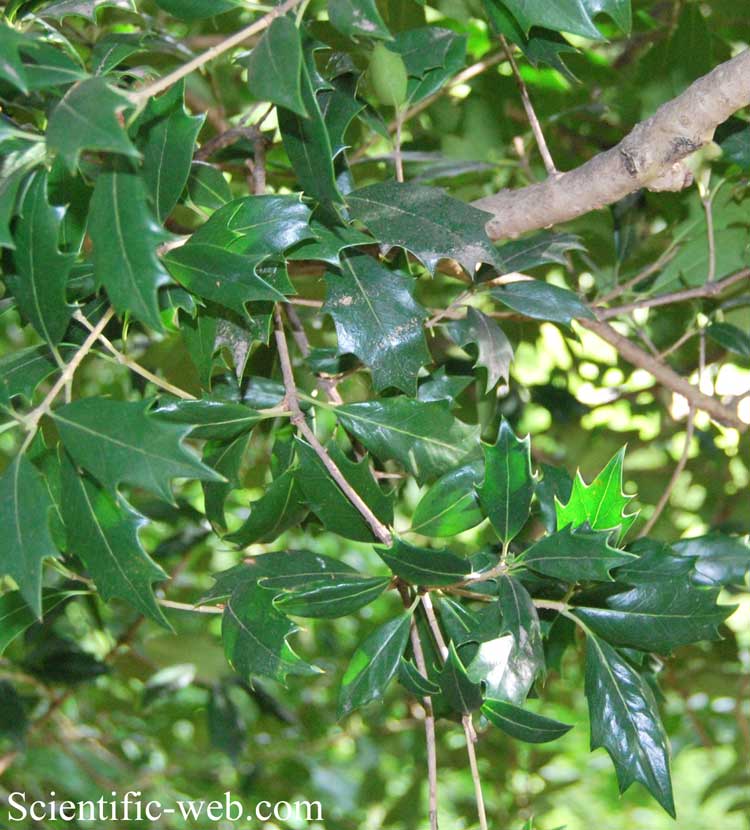
Osmanthus heterophyllus var. heterophyllus, Photo: Michael Lahanas
Classification System: APG IV
Superregnum: Eukaryota
Regnum: Plantae
Cladus: Angiosperms
Cladus: Eudicots
Cladus: Core eudicots
Cladus: Asterids
Cladus: Lamiids
Ordo: Lamiales
Familia: Oleaceae
Tribus: Oleeae
Subtribus: Oleinae
Genus: Osmanthus
Sectio: O. sect. Osmanthus
Species: Osmanthus heterophyllus
Name
Osmanthus heterophyllus (G.Don) P.S.Green
References
Notes from the Royal Botanic Garden, Edinburgh. Edinburgh and Glasgow 22:508. 1958
USDA, ARS, Germplasm Resources Information Network. Osmanthus heterophyllus in the Germplasm Resources Information Network (GRIN), U.S. Department of Agriculture Agricultural Research Service. Accessed: 07-Oct-06.
Vernacular names
English: Holly Osmanthus, Chinese Osmanthus
日本語: ヒイラギ
Osmanthus heterophyllus (Chinese:t 柊樹, s 柊树, p zhōngshù; Japanese: 柊, Hiiragi), variously known as holly osmanthus, holly olive, and false holly, is a species of flowering plant in the olive family Oleaceae, native to eastern Asia in central and southern Japan (Honshū, Kyūshū, Shikoku, and the Ryukyu Islands) and Taiwan.[2][3]
Description
It is an evergreen shrub or small tree growing to 2–8 m (7–26 ft) tall. The bark is brown to grey or blackish, cracking into small plates on old plants. The leaves are opposite, 3–7 cm long and 1.5–4 cm broad with a thick, leathery texture, lustrous dark green above, paler yellow-green below; the margin is entire or with one to four large spine-tipped teeth on each side. Spiny leaves predominate on small, young plants (an adaptation to deter browsing animals), while entire leaves predominate higher on larger mature plants out of the reach of animals. The flowers are very fragrant, white, with a four-lobed corolla, the corolla tube 1–2 mm long and the lobes 2.5–5 mm long; they are dioecious, with flowering in the autumn. The fruit is an ovoid dark purple drupe 1.5 cm long and 1 cm diameter, mature in the following summer about 9 months after flowering.[2][4][5][6]
Varieties
There are two varieties:[2]
Osmanthus heterophyllus var. heterophyllus. Leaves entire or spiny; flowers with short corolla lobes 2.5-3.5 mm long. Throughout the range of the species.
Osmanthus heterophyllus var. bibracteatus (Hayata) P.S.Green. Leaves always entire; flowers with long corolla lobes 5 mm long. Endemic to Taiwan.
Nomenclature
Osmanthus is derived from Greek and means 'fragrant flower'.[7]
The scientific name heterophyllus, "different leaves", refers to the variation in leaf shape between spiny and entire. The common name holly osmanthus refers to the similarity in leaf shape to that of the holly (Ilex aquifolium), an example of convergent evolution with a common objective of deterring browsing; the two may be distinguished easily by the leaf arrangement, alternate in Ilex aquifolium and opposite in Osmanthus heterophyllus.
Cultivation
‘Goshiki’, Cranford, New Jersey
It is widely used as a hedge plant.[6][8] Several cultivars have been selected for garden use, including 'Aureus', 'Goshiki', 'Purpureus', 'Rotundifolius', and 'Subangustatus'.[6] The cultivars 'Goshiki',[9] 'Variegatus'[10] and ‘Purple Shaft’ have gained the Royal Horticultural Society's Award of Garden Merit.[11]
The species has been hybridised in cultivation with Osmanthus fragrans; the resulting hybrid is named Osmanthus × fortunei Carr.[6]
Historical mentions
It is mentioned twice in the Kojiki, the oldest surviving historical record of Japan.[8] The first mention, under the name hihiragi, is in connection with the name of a kami, Hihiragi-no-sono-hana-madzumi-no-kami[12] (translated by Chamberlain as "Deity Waiting-to-see-the-Flowers-of-the-Holly"[13]), with the word madzumi (rarely seen) being used to describe the plant's characteristic of its flowers rarely blossoming, as interpreted by the scholar Tominobu.[8][14] Its second mention occurs during a passage referring to how a holly wood spear, made of material from the tree and spanning "eight fathoms long",[15] was presented to the Prince Yamato-take by the Emperor prior to him being sent to subdue the East.[8] Its prickly and non-prickly variations are sometimes described as "male" and "female" respectively, though this does not have a relation to the plant's gender.[8][16]
References
"The Plant List".
Flora of China: Osmanthus heterophyllus
"Osmanthus heterophyllus". Germplasm Resources Information Network (GRIN). Agricultural Research Service (ARS), United States Department of Agriculture (USDA). Retrieved 2 January 2018.
Hata Labs Plant Ecology Laboratory: Osmanthus heterophyllus (in Japanese; google translation)
Rokko Mountain guide to trees: Osmanthus heterophyllus Archived 2005-05-25 at the Wayback Machine (in Japanese; google translation)
Huxley, A., ed. (1992). New RHS Dictionary of Gardening. Macmillan ISBN 0-333-47494-5.
Gledhill, David (2008). "The Names of Plants". Cambridge University Press. ISBN 9780521866453 (hardback), ISBN 9780521685535 (paperback). pp 285, 410
Sakanishi, Shio (December 1935). "The Magic Holly in Japanese Literature". Journal of the American Oriental Society. 55 (4): 444–450. doi:10.2307/594762. JSTOR 594762.
"RHS Plant Selector - Osmanthus heterophyllus 'Goshiki'". Retrieved 14 September 2019.
"RHS Plant Selector - Osmanthus heterophyllus 'Variegatus'". Retrieved 25 May 2013.[permanent dead link]
"AGM Plants - Ornamental" (PDF). Royal Horticultural Society. 2018. p. 71. Retrieved 14 September 2019.
Kojiki. pp. vol. 2, sect. 26.
Chamberlain, Basil Hall (1932). Kojiki (2nd ed.). pp. 100.
Hosoda, Tominobu. Jindai seigo tokiwa-gusa.
Chamberlain, Basil Hall (1932). Kojiki (2nd ed.). pp. 22.
Matsuoka, Gentatsu (c. 1800). Honzo ikka gen.
Retrieved from "http://en.wikipedia.org/"
All text is available under the terms of the GNU Free Documentation License

